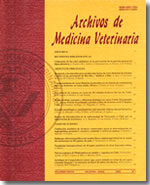Evaluation of sedation and analgesia protocols with xylazine and two rates of morphine by continuous infusion in stationary horses undergoing laparoscopic castration
Main Article Content
Abstract
The aim of the study was to evaluate the use continuous infusion of morphine at two different doses on levels of sedation and analgesia in laparoscopic castration on stationary horses. 14 healthy horses between 3 and 6 years, weighing 239-369 kg were used, the animals were given xylazine (0.6 mg /kg IV), morphine (0.05 mg/kg/IV) and continuous infusion of morphine randomised (20 or 30 mcg /kg/h IV) to make transection of testicular artery and vein by standing laparoscopy by the flank. The degree of ataxia, sedation and analgesia were assessed and gastrointestinal motility was evaluated by auscultation and ultrasound. During anaesthetic and surgical procedures, animals from both protocols showed good cardiovascular stability and all the patients had mild to moderate sedation. Ataxia was moderate at the beginning of surgery and during anaesthetic procedure (after the bolus of xylazine), and at the end of surgery the animals showed mild to moderate ataxia. About 93 % of the animals showed mild to moderate degree of analgesia to painful surgical stimuli, mainly during flank surgical approach and ligation and cutting of the testicular neurovascular bundle. Intestinal motility decreased during anesthesia but all animals recovered completely the intestinal motility at 6 hours post-surgery. Anaesthetic and surgical procedures were suitable for laparoscopic abdominal surgery in horses, with good cardiovascular and respiratory stability and without post-intervention gastrointestinal complications.

